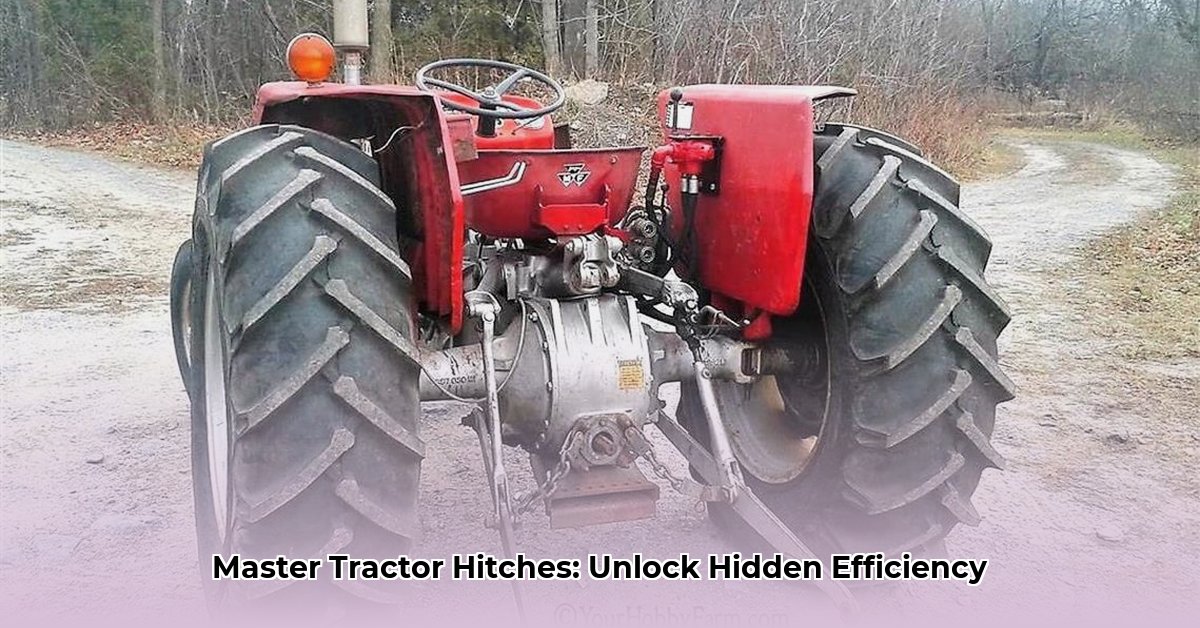
Choosing the right tractor hitch is crucial for sustainable and efficient farming. It's not merely about connecting equipment; it's about optimizing operations, minimizing environmental impact, and maximizing profitability. This guide explores various hitch types, selection criteria for sustainable practices, maintenance best practices, and emerging technological trends. For added strength and stability, consider a 3-point hitch turnbuckle.
Tractor Hitch Systems: Optimizing Your Sustainable Farm
The tractor hitch acts as the interface between your tractor and implements, significantly impacting efficiency and sustainability. Understanding the different types available is paramount to selecting the best fit for your farming operation. Did you know that the right hitch can significantly reduce fuel consumption and emissions? Let's delve into the specifics.
Understanding Tractor Hitch Types
Several hitch types cater to diverse needs and farming styles. The choice depends on your tractor’s size, the implements used, and the complexity of your operations.
Category 1, 2, and 3 Hitches: These are classified by size and lifting capacity. Category 1 hitches are ideal for smaller, more fuel-efficient tractors commonly employed in precision farming, minimizing fuel consumption and emissions. Category 3 hitches handle larger, heavier implements, often demanding higher fuel consumption. Category 2 provides a middle ground. Choosing the correct category is essential for optimal performance and efficiency.
Quick-Hitch Systems: These enable rapid implement changes, minimizing downtime between tasks. This translates to improved time management and reduced fuel use compared to slower, manual hitching methods. How much time do you estimate you save annually with a quick-hitch system?
Other Hitch Options: Drawbar hitches are suited for pulling trailers, while front-end loaders require specialized hitches for their specific function. The best choice hinges on the tasks performed on your farm.
| Hitch Type | Size/Capacity | Ideal Use | Sustainability Benefits |
|---|---|---|---|
| Category 1 | Small tractors | Precision farming, smaller fields | Reduced fuel consumption, lower emissions |
| Category 2 | Medium-sized tractors | General fieldwork, moderate implements | Balanced efficiency and environmental impact |
| Category 3 | Large tractors | Large-scale operations, heavy implements | Potentially higher fuel consumption |
| Quick-Hitch System | Varies | Frequent implement changes | Reduced downtime, improved efficiency |
Choosing the Right Hitch for Sustainable Practices: A Strategic Decision
Selecting a hitch involves more than just lifting capacity; it's about aligning it with your sustainable farming methods:
Fuel Efficiency: Smaller tractors with Category 1 hitches generally offer better fuel economy, directly contributing to reduced emissions and lower operating costs. Have you considered the long-term cost savings of fuel efficiency?
Implement Compatibility: Ensuring compatibility between your implements and hitch is non-negotiable. Mismatched equipment leads to inefficiency and potential damage.
Precision Farming: Smaller hitches often pair well with precision farming techniques, enabling precise application of fertilizers and pesticides, minimizing waste and environmental impact.
No-Till Farming: Carefully selecting the right hitch for no-till implements is crucial for maintaining soil health, optimizing water retention, and reducing erosion. No-till practices profoundly affect soil health, so compatibility is critical.
Maintaining Your Hitch: Maximizing Lifespan and Minimizing Waste
Regular maintenance is key to optimal hitch performance and extends its useful life. This reduces the environmental burden of frequent replacements and ensures continued efficiency.
Regular Inspections: Conduct a visual inspection before each use, addressing loose bolts, worn parts, or any signs of damage promptly.
Lubrication: Regular lubrication of moving parts prevents corrosion, smooths operation, and extends lifespan.
Fastener Tightening: Periodically check and tighten all nuts and bolts. Loose fasteners can compromise safety and lead to failures.
Prompt Part Replacement: Replacing worn components immediately prevents larger, more expensive repairs down the line.
Professional Servicing: Schedule regular professional servicing for comprehensive inspections and maintenance to identify potential issues early on.
Emerging Trends: The Future of Sustainable Hitch Technology
Agricultural technology continues to evolve, promising even greater efficiency and sustainability:
Smart Hitches: Integration of sensors and GPS technology provides precise implement control. This enhances data collection, leading to improved efficiency and reduced waste.
Automated Hitch Systems: Automated systems simplify attachment and detachment of implements, improving accuracy and safety, while reducing human error.
Farm Management Software Integration: Seamless integration with farm management software provides real-time data and insights for optimized operations.
These advancements offer significant potential for improved productivity and reduced environmental impact.
Conclusion: Investing in a Sustainable Future
Choosing and maintaining the appropriate tractor hitch is paramount for sustainable and profitable farming. It’s about optimizing efficiency, minimizing environmental impact, and ensuring long-term economic viability. By making informed decisions on hitch selection and implementing proper maintenance, farmers contribute to a more sustainable agricultural sector. Staying abreast of emerging technologies is crucial in this constantly evolving field.